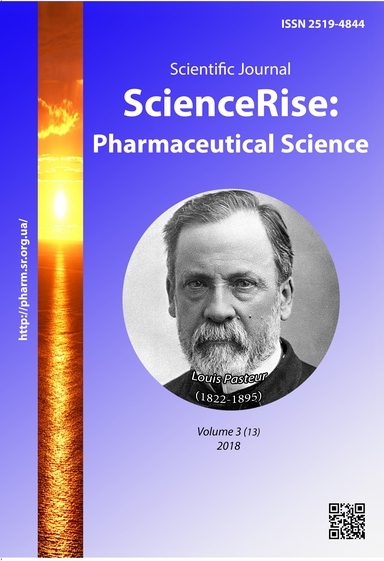Фітохімічне та фармакологічне дослідження полісахаридних комплексів плодів prunus domestica
DOI:
https://doi.org/10.15587/2519-4852.2018.135825Ключові слова:
слива, екстракт, полісахариди, елементи, гістоструктура, печінка щурів, інтоксикація етаноломАнотація
Ціль. Метою нашої роботи було провести фракціонування полісахаридних комплексів з свіжих плодів сливи, дослідити елементний склад свіжих плодів сливи, провести порівняльне дослідження вмісту нейтральних моноцукрів у одержаних комплексах, та дослідити їх вплив на гістоструктуру печінки щурів в умовах етанольної інтоксикації
Методи. Аналіз макро- та мікроелементів проводили на атомно-емісійному спектрофотометрі ISE 3500 (Thermo Scientific, США). Вміст полісахаридних фракцій, таких як: волокна, водорозчинний полісахаридний комплекс (ВПК) та пектин, проводили гравіметричним методом. Порівняльне вивчення вмісту моносахаридів у отриманих фракціях проводили з додаванням пікринової кислоти на спектрофотометрі Hewlett Packerd 8453 при довжині хвилі 463 нм у кюветі з товщиною шару 10 мм.
Досліджено вплив волокон та ВПК плодів сливи на гістоструктуру печінки щурів на моделі інтоксикації етанолом.
Результати. У результаті досліджень визначено елементний склад плодів сливи з найбільшим вмістом калію – 2000 мкг/100г. Вміст важких металів у плодах сливи не перевищував норм, встановлених Державною фармакопеєю України. Зі свіжих плодів сливи були отримані три фракції полісахаридів: волокна, ВПК і пектини. Найбільший вміст нейтральних цукрів було визначено у ВПК – 61,52±1,47 %,. їх вміст в волокнах та пектині склав: 59,23±1,15 % та 22,85±0,55 % відповідно.
Було підтверджено, що одночасне вживання етанолу з волокнами плодів сливи в дозі 200 мг/кг запобігає розвитку жирової дистрофії паренхіми печінки, на відміну від аналогічної схеми введення ВПК плодів сливи у тій самій дозі та препарату порівняння силібор в дозі 30 мг/кг.
Висновки. Враховуючи результати фітохімічних та фармакологічних досліджень, можна зробити висновок, що волокна плодів сливи є перспективними для подальшого дослідження з метою створення нових ефективних і безпечних лікарських засобів з метою їх використання в медичній практиці
Посилання
- Chernykh, V. P. (Ed.) (2010). Farmatsevtychna entsyklopediya. Kyiv: MORION, 1952.
- Stickney, J. C., Van Liere, E. J., Northup, D. W. (1951). Correlation Between Propulsive Motility and Length of the Small Intestine in Albino Rats and Dogs. American Journal of Physiology-Legacy Content, 167 (2), 399–402. doi: http://doi.org/10.1152/ajplegacy.1951.167.2.399
- Celik, F., Gundogdu, M., Alp S., Muradoglu, F., Ercişli, S., Gecer, M. K., Canan, I. (2017). Determination of phenolic compounds, antioxidant capacity and organic acids contents of Prunus domestica L., Prunus cerasifera Ehrh. and Prunus spinosa L. fruits by HPLC. Acta Chromatographica, 29 (4), 507–510. doi: http://doi.org/10.1556/1326.2017.00327
- Senyuk, I. V., Bashar, A.-S. J., Lenchyk, L. V. (2017). Investigation of different substances catharic properties made from Prunus domestica. Ukrainian biopharmaceutical journal, 5 (52), 21–25. doi: http://doi.org/10.24959/ubphj.17.134
- Mohammed Shahm Basim, Lenchik, L. V., Caidov, N. B. (2017). Plody slivy domashney – perspektivnoe syr'e dlya sozdaniya lekarstvennyh sredstv. Nauka i innovaciya. Seriya estestvennyh nauk, 4, 42–48.
- The State Pharmacopoeia of Ukraine (2008). Kharkiv: RІRЕG, 620.
- Koshovyi, O. M., Zaitsev, H. P., Kovalova, A. M., Komisarenko, A. M. (2012). Doslidzhennia aminokyslotnoho ta monotsukrovoho skladu spyrtovoho ekstraktu z lystia evkaliptu prutovydnoho. Farmakom, 1-2, 46–49.
- Belousov, M. V., Cybukova, T. N., Berezovskaya, T. P., Tihonova, O. K., Basova, E. V., Zeyle, L. A., Yusubov, M. S. (2002). Elementniy sostav bagul'nika bolotnogo. Himiya rastitel'nogo syr'ya, 4, 35–38.
- Kabata-Pendias, A. (2010). Trace elements in soils and plants. New York: CRC press, 548. doi: http://doi.org/10.1201/b10158
- Merkulov, G. A. (1969). Kurs patologogistologicheskoy tekhniki. Leningrad: Medicina, 424.
- Serov, V. V., Lapish, K. (1989). Morfologicheskaya diagnostika zabolevaniy pecheni. Moscow: Medicina, 336.
##submission.downloads##
Опубліковано
Як цитувати
Номер
Розділ
Ліцензія
Авторське право (c) 2018 Taras Upyr, Shahm Basim Mohammed, Al-Jabbar Ali Sahlani Bashar, Larysa Lenchyk, Igor Senyuk, Viktoria Kyslychenko

Ця робота ліцензується відповідно до Creative Commons Attribution 4.0 International License.
Наше видання використовує положення про авторські права Creative Commons CC BY для журналів відкритого доступу.









